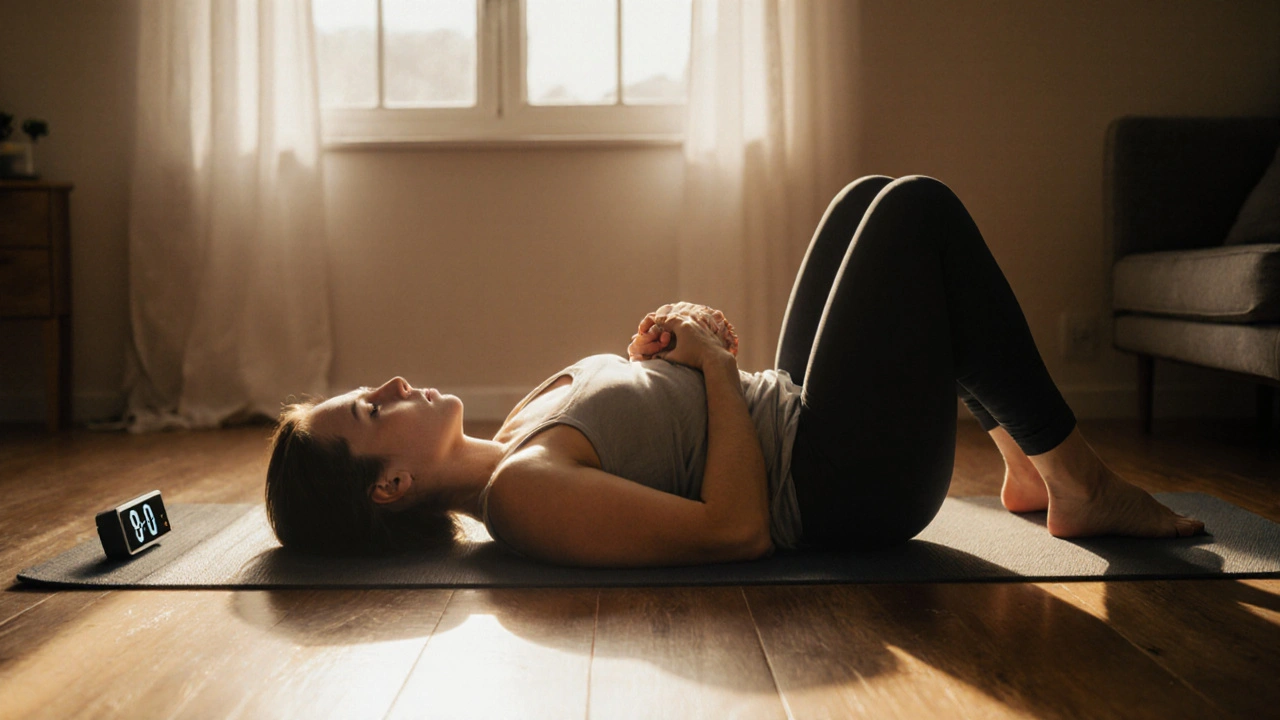Fascia Stretching: A Powerful Tool for Muscle Recovery

Fascia Release Timer
When you wake up stiff after a long run, or feel tightness in your hamstrings days after a workout, it’s not just your muscles holding you back. It’s your fascia.
What Fascia Actually Is (And Why It Matters)
Fascia is the invisible web of connective tissue that wraps around every muscle, bone, nerve, and organ in your body. Think of it like shrink-wrap that keeps everything in place and connected. Healthy fascia is slippery and flexible, letting your muscles glide smoothly during movement. But when it gets stuck - from injury, inactivity, or repetitive motion - it turns into sticky glue. That’s when you feel tight, achy, or restricted, even if your muscles are strong.
Most people think stretching is about lengthening muscles. But the real bottleneck? The fascia. A 2023 study from the Journal of Bodywork and Movement Therapies found that people who focused on fascial release improved their range of motion 40% faster than those who only stretched muscles. That’s because fascia responds to slow, sustained pressure - not quick bounces or forced holds.
Why Regular Stretching Isn’t Enough
You’ve probably done toe touches, quad stretches, or shoulder rolls after a workout. But if you’re still feeling stiff, it’s because those moves don’t target fascia. Muscles shorten and lengthen quickly. Fascia doesn’t. It needs time. Think of it like a wet towel: if you yank it, it snaps back. But if you hold it gently and let it soak, it slowly relaxes.
Traditional static stretching holds a position for 20-30 seconds. Fascia stretching? You hold for 90 to 120 seconds. And you don’t push hard. You just settle in. Let your body sink. Breathe. Wait. That’s when the collagen fibers in your fascia begin to reorganize. That’s when mobility actually changes.
How Fascia Stretching Works
Fascia stretching isn’t about intensity - it’s about patience. Here’s how it works in practice:
- Find the tight spot - often near joints or where muscles meet tendons.
- Get into a gentle stretch - no pain, just mild tension.
- Hold for 90 seconds minimum. Use a timer.
- Breathe slowly. Let your body melt into the stretch.
- Repeat 2-3 times per area, 3-4 times a week.
For example, if your lower back feels locked after sitting all day, try this: lie on your back, hug both knees to your chest, and let your spine rest on the floor. Don’t pull. Just breathe. After 90 seconds, you’ll feel your spine start to release. That’s fascia letting go.
Another simple move: sit on the floor with one leg extended, the other bent. Gently lean forward from your hips - not your waist. Keep your back flat. Hold for two minutes. You’re not trying to touch your toes. You’re letting the fascia along your hamstrings and lower back soften.

Tools That Help - And Ones That Don’t
You don’t need fancy gear. But some tools make it easier.
Best for fascia:
- Soft foam rollers (not hard PVC)
- Trigger point balls (tennis or lacrosse balls)
- Stretch straps or towels for guided holds
Avoid:
- Hard metal rollers - they bruise, don’t release
- Violent bouncing - it triggers muscle defense, not fascial change
- Overdoing it - more than 10 minutes per session can inflame tissue
One client I worked with in Adelaide - a 52-year-old cyclist - was stuck with chronic hip pain. He’d been foam rolling for months with a hard roller, pushing hard. No improvement. We switched to a soft ball, held gently on his glutes for 2 minutes, twice a day. Within three weeks, his pain dropped by 70%. He wasn’t stretching harder. He was stretching smarter.
When to Do Fascia Stretching
Timing matters. Do it after your workout, when your body is warm. That’s when fascia is most pliable. But you can also do it on rest days - even just 10 minutes in the morning helps reset your whole system.
Don’t do it cold. Never stretch frozen muscles. That’s when you risk tearing fascia. Warm up first - walk for five minutes, do light arm circles, or take a warm shower.
And don’t skip recovery days. Fascia rebuilds slowly. Give it 48 hours between deep sessions. Overworking it leads to inflammation, not improvement.
Signs You’re Doing It Right
How do you know if fascia stretching is working?
- You feel a softening, not a sharp pain
- Your movement feels freer the next day
- Stiffness decreases over time, not just after the stretch
- You sleep better - fascia tension affects your nervous system
If you feel bruising, burning, or sharp pain - stop. That’s not release. That’s damage. Fascia responds to gentle, consistent pressure. Not force.

Who Benefits Most
Fascia stretching isn’t just for athletes. It helps anyone who moves - or sits.
- Office workers with tight shoulders and necks
- Runners with IT band pain
- Parents carrying kids all day
- Seniors losing mobility
- People recovering from surgery or injury
One woman in her 60s from Norwood told me she couldn’t bend down to tie her shoes. After six weeks of daily fascia stretches - just 12 minutes total - she could touch her toes. No surgery. No pills. Just patience.
Common Mistakes to Avoid
Even with good intentions, people mess this up.
- Stretching too fast - fascia doesn’t respond to speed
- Ignoring breathing - holding your breath locks tension
- Only stretching the painful spot - fascia connects across the whole body
- Skipping consistency - one session won’t change anything
- Comparing yourself to others - your fascia is unique
One big myth: you need to stretch every muscle. Nope. Focus on the areas that feel stuck. Often, tightness in your hip is caused by fascia in your lower back. Work the source, not the symptom.
Putting It All Together
Fascia stretching is simple. It’s not complicated. You don’t need a degree in anatomy. Just a timer, a quiet space, and the willingness to wait.
Start small. Pick one area that’s always tight - maybe your calves, your shoulders, or your lower back. Spend 90 seconds on it every morning. Do it for 14 days. Then check in. Can you move easier? Do you feel less stiffness? That’s your proof.
It’s not magic. It’s biology. Your body wants to move. But fascia gets stuck. And with the right kind of attention, it can let go.
Can fascia stretching help with chronic pain?
Yes. Many people with chronic lower back, shoulder, or knee pain find relief through fascia stretching because it releases tension trapped in connective tissue, not just muscles. Studies show it reduces pain signals by calming the nervous system. It’s not a cure-all, but it’s one of the most effective non-drug tools for long-term pain management.
How often should I do fascia stretching?
Three to four times a week is ideal for most people. If you’re very stiff or recovering from injury, daily 10-minute sessions work well. But don’t overdo it. Fascia needs time to rebuild. If you feel sore the next day, take a rest day. Consistency beats frequency.
Is fascia stretching the same as foam rolling?
Not exactly. Foam rolling is a form of self-myofascial release - it’s pressure-based. Fascia stretching is hold-and-release based. Rolling breaks up adhesions; stretching reorganizes tissue. They work best together. Roll for 30 seconds, then hold a stretch for 90 seconds in the same area.
Can I do fascia stretching after a workout?
Absolutely. In fact, that’s the best time. Your muscles and fascia are warm, more pliable, and primed for release. Do it right after cooling down - before you shower or get dressed. It helps reduce next-day soreness and speeds up recovery.
Does fascia stretching improve posture?
Yes. Tight fascia pulls your body out of alignment - rounded shoulders, forward head, tilted pelvis. Releasing it allows your skeleton to return to its natural position. You won’t just feel looser - you’ll stand taller without trying.
What if I don’t feel anything during the stretch?
That’s normal - especially at first. Fascia doesn’t always signal you. Don’t wait for a sensation. Just hold the position. The changes happen below the surface. After a few sessions, you’ll start noticing subtle shifts - easier breathing, less stiffness when you stand up, or a better range of motion without effort.
If you’ve been pushing through tightness, pain, or stiffness - it’s time to try something different. Your body isn’t broken. Your fascia is just stuck. And with a little patience, it can heal.





